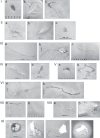Perforation rates in double latex gloves and protective effects of outer work gloves in a postmortem examination room: A STROBE-compliant study
- PMID: 31277191
- PMCID: PMC6635159
- DOI: 10.1097/MD.0000000000016348
Perforation rates in double latex gloves and protective effects of outer work gloves in a postmortem examination room: A STROBE-compliant study
Abstract
Medical staff face the risk of exposure to blood-borne infectious agents during postmortem examinations. This study investigated the effectiveness of non-slip work gloves worn over 2 layers of surgical latex gloves (outer and inner gloves) as a means of reducing hand and finger injuries. Complete sets of outer and inner gloves worn during postmortem examinations were collected from participating forensic staff. Latex gloves were categorized into 2 groups based on the users' actions during the examination: the wearing group if the wearer wore their work gloves continuously without interruption, and the taking-off group if the wearer removed them at least once. Perforation rates, locations, and shapes were compared between these groups. Outer-glove perforation occurred significantly more often in the taking-off group (n = 102 pairs) than in the wearing group (n = 91 pairs) (30.4% vs 3.8%, P < .001). Inner-glove perforation occurred at rates of 2.0% and 0.5% (P = .38), respectively. The wearers did not incur hand or finger injuries. Perforation rates were similar between the dominant and non-dominant hands (P = .18). Regarding location, gloves were punctured most frequently at the thumb, followed by the index finger. Most examiners (85.6%) did not notice the perforation when the damage occurred. Therefore, we could not confirm that a specific operation within a set of plural operations affected the rate of perforation. Additionally, we could not prove a relationship between glove perforation and each operation performed with/without work gloves. The perforation appearances varied greatly in shape and size, suggesting multiple causes of perforation. The continuous (i.e., uninterrupted) wear of work gloves during postmortem examinations reduced the incidence of perforations in both latex glove layers and thus reduced the risk of hand and finger injury.
Conflict of interest statement
The authors declare no conflicts of interest.
Figures




Similar articles
-
Surgical glove perforations in otolaryngology: prevention with cut-resistant gloves.Otolaryngol Head Neck Surg. 1993 Jan;108(1):91-5. doi: 10.1177/019459989310800114. Otolaryngol Head Neck Surg. 1993. PMID: 8437881
-
Outer gloves in orthopaedic procedures: a polyester/stainless steel wire weave glove liner compared with latex.J Orthop Trauma. 1998 Feb;12(2):101-5. doi: 10.1097/00005131-199802000-00006. J Orthop Trauma. 1998. PMID: 9503298 Clinical Trial.
-
The protective effect of a cut-resistant glove liner. A prospective, randomised trial.J Bone Joint Surg Br. 1998 May;80(3):411-3. doi: 10.1302/0301-620x.80b3.8041. J Bone Joint Surg Br. 1998. PMID: 9619927 Clinical Trial.
-
[Surgical gloves--how well do the protect against infections?].Gesundheitswesen. 1999 Aug-Sep;61(8-9):398-403. Gesundheitswesen. 1999. PMID: 10535220 Review. German.
-
[Defects in the surgical glove barrier. Single or double gloves].Ugeskr Laeger. 2003 Mar 3;165(10):1016-9. Ugeskr Laeger. 2003. PMID: 12645406 Review. Danish.
Cited by
-
Design and Manufacture of Data Gloves for Rehabilitation Training and Gesture Recognition Based on Flexible Sensors.J Healthc Eng. 2021 Dec 7;2021:6359403. doi: 10.1155/2021/6359403. eCollection 2021. J Healthc Eng. 2021. Retraction in: J Healthc Eng. 2023 Dec 6;2023:9815234. doi: 10.1155/2023/9815234. PMID: 34917309 Free PMC article. Retracted.
References
-
- The Japan Society of Hepatology. White Paper on Liver cancer; 2015.
-
- AIDS Prevention Information Network. Japan Foundation for AIDS Prevention. Available at: http://api-net.jfap.or.jp/status/2018/1803/20180316_HYO-02.pdf. In Japanese Accessed June 25, 2019.
-
- Halstead WS. Surgical Papers. Baltimore: Johns Hopkins Press; 1924.
-
- Schlich T. Why were surgical gloves not used earlier? Lancet 2015;386:1234–5. - PubMed
Publication types
MeSH terms
Substances
LinkOut - more resources
Full Text Sources
Medical

